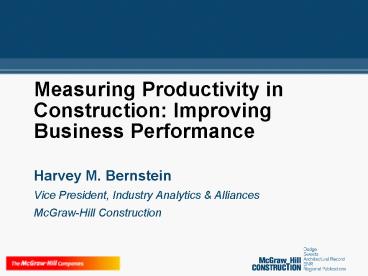Measuring Productivity in Construction: Improving Business Performance PowerPoint PPT Presentation
1 / 24
Title: Measuring Productivity in Construction: Improving Business Performance
1
Measuring Productivity in Construction Improving
Business Performance
- Harvey M. Bernstein
- Vice President, Industry Analytics Alliances
- McGraw-Hill Construction
2
Productivity as Defined Today
construction contract expenditures in constant
dollars (output) divided by man-hours worked
(input).
3
Problems Measuring Productivity
- Macro data does not provide a clear or consistent
picture of industry productivity - Best indicator of productivity is accomplished at
the project level but it is difficult to
aggregate all project information - Variation by contractor and delivery approach is
significant - Delivery approach variances up to 17 (CURT)
- Owners, AEC firms, and BPMs lack agreement on
what metrics are most important to quantify
measuring performance
4
U.S. Productivity Gap (1964-2003)
Non-Farm
Construction
Reference Paul Teicholz, Ph.D., Professor
(Research) Emeritus, Dept. of Civil and
Environmental Engineering, Stanford University
5
Canada Total Factor Productivity in the Business
and Construction Sectors, 1961-2001
6
Who needs to know how to measure productivity and
have access to an Industry Performance Rating
System?
- The thousands of firms who must wisely evaluate
and select GCs, Subs, AE firms, BPMs, Products,
and Distributors.
7
Who will benefit from an Industry Performance
Rating System?
- Owners to select the best AEC firms
- GCs and Design firms to promote their rankings
- Distributors -to represent the best BPMs and BPMs
who want to partner with the best Distributors - Firms -to expand thru partnering or buying Firms
- Lenders -to minimize risks of construction
lending - Insurance firms -seeking an objective,
third-party source of contractor and project
ratings - Government Agencies -for cost estimating and
project cost comparisons
8
What about labors influence?
- Multiple studies show productive work (direct
work) accounts for only about 1/3 of workers time - Work site communications are inadequate
- Material handling time has to be reduced
- Waiting time has to be reduced through better
integration/scheduling with suppliers - Track/manage productivity at the project level to
establish a benchmark for future improvements
9
Labor Rates
Reference Paul Teicholz, Ph.D., Professor
(Research) Emeritus, Dept. of Civil and
Environmental Engineering, Stanford University
10
Keys to Effectiveness
- Effective use of subcontractor and labor
- Level of craft training
- Familiarity with means and methods
- Effectiveness of supervision/project management
- Influence of wages
- Union vs Non-union
- Common work culture (safety)
11
Safety as an example
- First items on every agenda
- Part of corporate culture
- Recognizes that a safe work site is also an
efficient work site
12
Higher Wage Rates Do They Drive Productivity?
Source Construction Labor Research Council,
March 2004.
13
Productivity Is Not Constant in a Complex Industry
14
Combining Multiple Factors in Measuring
Productivity
15
Unit Cost Comparison
- Building Type Cost/s.f. Cost/s.f. 2003 Cost
1965-2003
1966 2003 Adjusted
to Decrease - 1996
- Warehouse 4.30 21.00 3.70 (14.0)
- Retail 13.00 63.33 11.15 (14.3)
- Office 18.50 91.00 16.02 (13.4)
- Multifamily Residential 9.10 45.50
8.09 (11.1) - Weighted Average (12.3)
Source Haskell, 2005
16
Quality and Content Enhancements
- Category 40-year Cost Impact
- Fire and Life Safety 3.1
- Seismic and Windstorm Resistance 1.6
- Life-cycle Cost Expectancy, Quality 3.3
- Sustainability, Environmental Quality 2.7
- Impact Fees, Offsite Improvements 1.2
- Accessibility Compliance (ADA) 1.3
- Enhanced Security Features 1.0
- Improved Energy Efficiency 2.8
- Indoor Air Quality, Mold, Asbestos 1.6
- Total 18.6
Source Haskell, 2005
17
Summary - Output Approach
- Unit Cost Decrease 12.3
- Quality and Content Increase 18.6
- Total Productivity Increase 33.2
Source Haskell, 2005
18
Summary - Input Approach
- Labor Productivity Increase 15.3
- Materials Cost Decrease 21.1
- Capital Equipment Increase (4.0)
- Aggregate Productivity Increase 32.4
Source Haskell, 2005
19
Haskell Conclusions
- Output Approach 33.2
- Input Approach 32.4
- Rounded 33.0 0.78/year
- All other U.S. Industry 1.75/year
Source Haskell, 2005
20
Impact of CAD Activities
- CURT studies show 3D CAD provides 7 percent (and
up) improvement in labor productivity
7
21
Change impact management
- Any deviation from construction plan drives poor
productivity
?
- Disruption is the major impact
22
Industry Thoughts on Measuring Productivity
- Get industry buy-in on the criteria used.
- Find surrogates for data that will indicate
performance and enable some form of comparison. - Measurement rankings drive performance (e.g., ENR
rankings are used by clients when viewing
potential contractors). - Safety drives productivity and is a fundamental
indicator of quality and should be a factor in
measuring performance. - A quality team is indispensable to good
performance and should be considered.
23
Potential Areas for Productivity Increases
- Information Technology
- Project Delivery
- Automation and Prefabrication
- Workforce Development
- Materials
24
Benefits of Developing a Measurement and
Performance Rating System for the Construction
Industry
- new innovative products
- improved efficiency
- Improved performance
- Improved competitiveness
- higher profits
- increased market share

